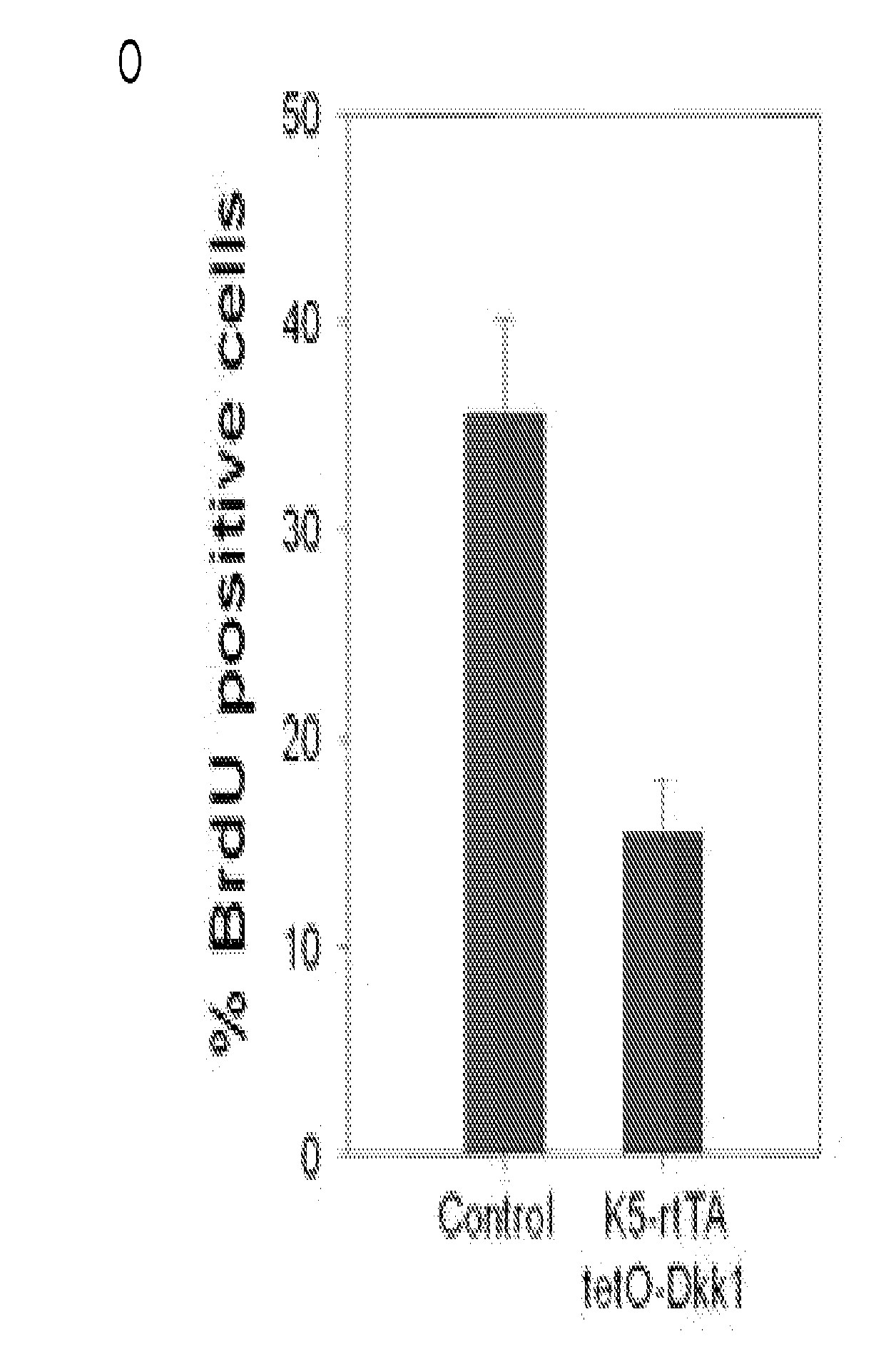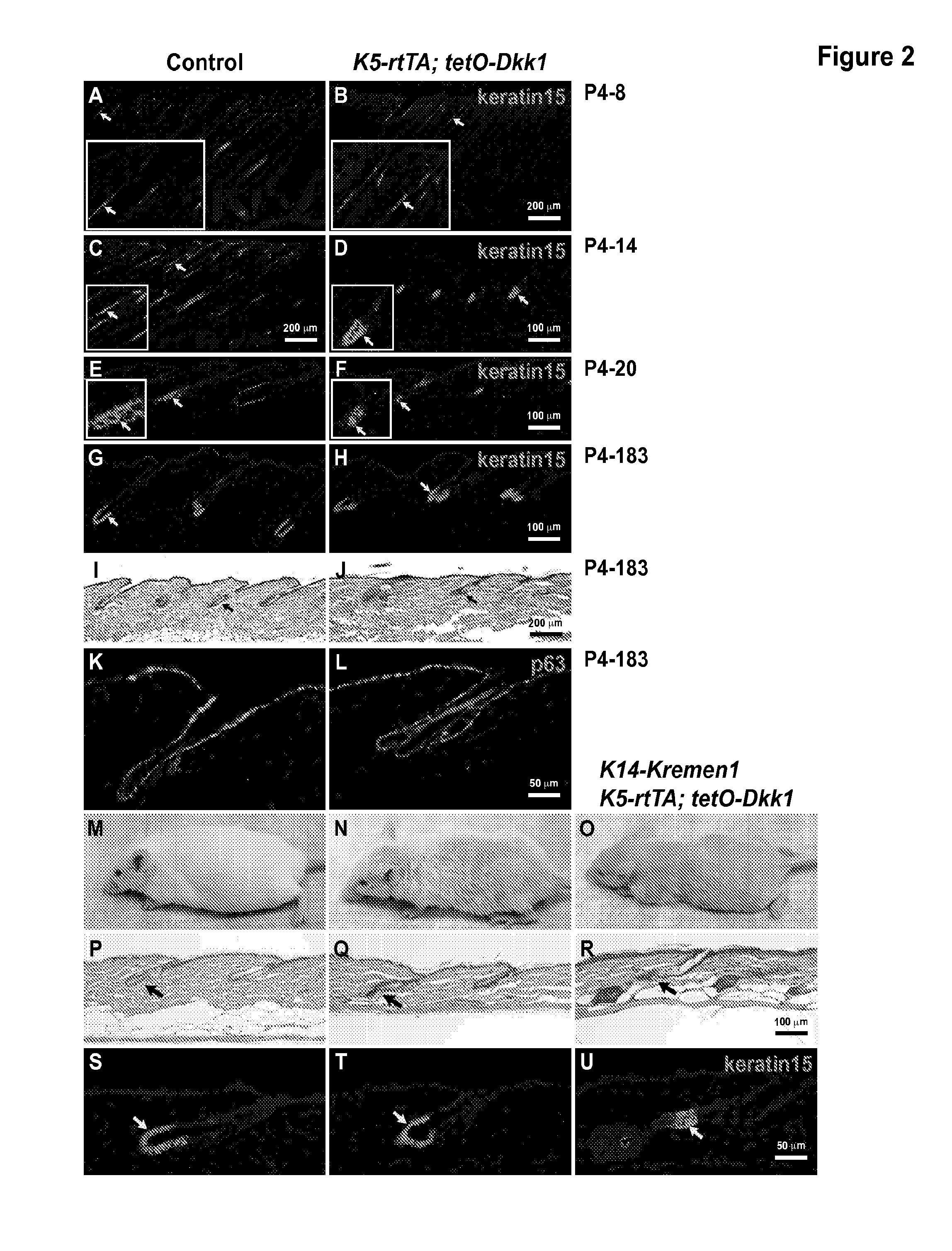Inhibition of hair follicle growth by the wnt inhibitor dkk1
- Summary
- Abstract
- Description
- Claims
- Application Information
AI Technical Summary
Benefits of technology
Problems solved by technology
Method used
Image
Examples
example 1
Ectopic Expression of Dkk1 During the Growth Phase of the Embryonic Hair Cycle Inhibits Proliferation and Causes Rapid Regression of Hair Follicles
[0147]We first examined the effects of ectopic expression of the Wnt inhibitor Dkk1 during the growth phase of the embryonic hair cycle. Expression of Dkk1 was induced at postnatal day 4, and dorsal skin was harvested at postnatal days 8, 14, and 20. All K5-rtTA; tetO-Dkk1 double transgenic skin samples showed rapid regression of hair follicles, compared with controls (FIGS. 1A-1B, 1D-1E, and 1G-1H). Kremen1 is required for inhibition of Wnt signaling by Dkk1. While endogenous Kremen1 is expressed in the skin, variations in its levels during the hair growth cycle might affect Dkk1's inhibitory activity. We therefore also examined the effects of ectopic Dkk1 expression in K5-rtTA; tetO-Dkk1 triple transgenic mice that additionally carry a keratin 14 promoter-driven Kremen1 transgene. The dorsal skin of K14-Kremen1 transgenic mice showed in...
example 2
Induced Ectopic Expression of Dkk1 does not Affect Maintenance of Hair Follicle Stem Cells
[0149]To ask whether maintenance of hair follicle stem cells is affected by Wnt inhibition we used an antibody to keratin (K) 15, a specific marker for epithelial stem cells in the hair follicle bulge (Liu et al., 2003, J Invest Dermatol 121, 963-968). In contrast to the dramatic effects of Dkk1 expression on proliferation, expression of K15 was readily detected in the transgenic hair follicles (FIGS. 2B, 2D, and 2F). To determine whether hair follicles and their stem cells persist during long-term Wnt inhibition, we induced Dkk1 expression from postnatal day 4, and examined skin histology and expression of the K15 stem cell marker and p63 basal cell marker after 6 months. We found that K15 expression was similar in control and Dkk1 expressing hair follicles (FIGS. 2G-2H), and hair follicle structures were maintained during these long periods of Dkk1 expression (FIG. 2J). No difference in the e...
example 3
The Plucking-Induced Anagen Phase is Blocked by Ectopic Dkk1
[0150]We next asked whether ectopic Dkk1 expression could block onset of the anagen growth phase in adult hair follicles. Two animal groups were used for these experiments. For both groups, we began doxycycline induction of Dkk1 expression during telogen, either at postnatal day 18 or at postnatal day 51. For the P18-57 group, hair plucking was performed at postnatal day 52 to induce a new anagen growth phase, and skin histology was examined 5 days after depilation. For the P51-57 group, hair plucking was carried out on postnatal day 54, and dorsal skin was harvested at postnatal day 57, 3 days after depilation. In both cases, entry into the anagen growth phase was inhibited in Dkk1 expressing skin compared with controls (FIGS. 3A-3B and 3L-3M). K14-Kremen1; K5-rtTA; tetO-Dkk1 triple transgenic mice also showed failure of onset of the anagen growth phase (FIG. 6C). However, expression of the stem cell marker keratin 15 was ...
PUM
 Login to View More
Login to View More Abstract
Description
Claims
Application Information
 Login to View More
Login to View More - R&D
- Intellectual Property
- Life Sciences
- Materials
- Tech Scout
- Unparalleled Data Quality
- Higher Quality Content
- 60% Fewer Hallucinations
Browse by: Latest US Patents, China's latest patents, Technical Efficacy Thesaurus, Application Domain, Technology Topic, Popular Technical Reports.
© 2025 PatSnap. All rights reserved.Legal|Privacy policy|Modern Slavery Act Transparency Statement|Sitemap|About US| Contact US: help@patsnap.com



